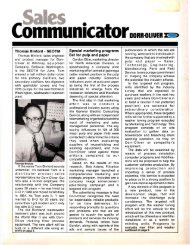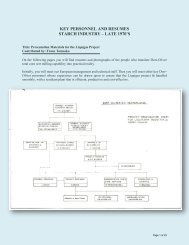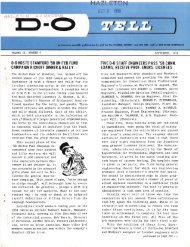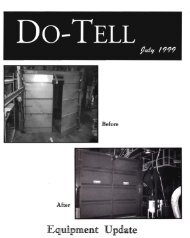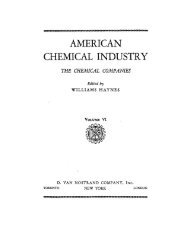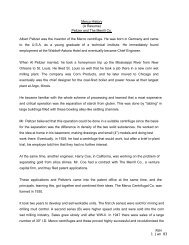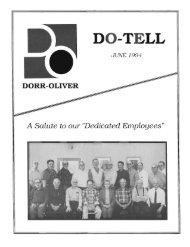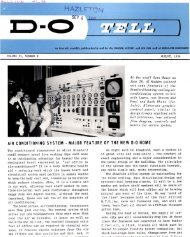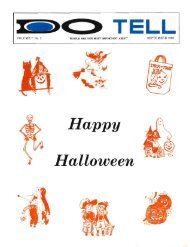Welcome to Dorr-Oliver's Open House - Dorr-Oliver Alumni
Welcome to Dorr-Oliver's Open House - Dorr-Oliver Alumni
Welcome to Dorr-Oliver's Open House - Dorr-Oliver Alumni
Create successful ePaper yourself
Turn your PDF publications into a flip-book with our unique Google optimized e-Paper software.
While all of this was taking place the Hazle<strong>to</strong>n plant was<br />
having its own auspicious beginning.<br />
Ernest J . Sweetland, an inven<strong>to</strong>r whose career paralleled<br />
that ofE. L. <strong>Oliver</strong> and Dr. <strong>Dorr</strong>, played the major role in the<br />
company's early development in Hazle<strong>to</strong>n. The inven<strong>to</strong>r of<br />
the Sweetland Filter and a pioneer in industrial filtration, he<br />
became president of the United Filter Corporation, a company<br />
formed from the American and Kelly Filter Companies<br />
and the Sweetland Filter Press Company. This company had<br />
its beginning in 1907.<br />
In 1919Sweetland looked for a plant site. He found a plant<br />
in Hazle<strong>to</strong>n with a foundry, office & machine shop. It was<br />
situated on thirteen acres of land, most of it wooded. He<br />
purchased the site, that ofthe present plant - and moved in.<br />
Almost immediately, plans were made for expanding the<br />
30,000 sq. ft. facilities and by the end of 1920, additions were<br />
completed bringing the <strong>to</strong>tal <strong>to</strong> 53,000 sq. ft. The company's<br />
products, the Sweetland Pressure Filter, American Disc Filter<br />
and Plate and Frame Presser found welcome markets,<br />
principally in the sugar producing industry and the metallurgical<br />
fields.<br />
In 1923, the manufacture of Kelly Filter was added at the<br />
plant and the period from 1920 <strong>to</strong> 1928 was marked with<br />
sizable growth for both the company and the plant itself. A<br />
pattern shop and s<strong>to</strong>rage building was completed in 1925 and<br />
the following year a north wing was added <strong>to</strong> the office building.<br />
Then in 1928, a second era in the his<strong>to</strong>ry of the plant began.<br />
This is the year that the United Filter Corp. and the <strong>Oliver</strong><br />
Continuous Filter Corp. merged <strong>to</strong> form the <strong>Oliver</strong> United<br />
Filters, Inc. The merger increased the combined operations<br />
line of products measurably. The staff in Hazle<strong>to</strong>n increased<br />
and in 1929, an expansion of the facility, which included a<br />
fabricating shop and a labora<strong>to</strong>ry, was completed. Many filters<br />
of <strong>Oliver</strong> origin began <strong>to</strong> appear on the assembly floor<br />
and in 1937 the original foundry building was converted <strong>to</strong> an<br />
assembly shop <strong>to</strong> accommodate the widened line of products<br />
manufactured.The outbreak of World War II brought United<br />
States industry <strong>to</strong> a hectic pace. In 1942, a long side bay was<br />
added <strong>to</strong> the assembly shop <strong>to</strong> provide for expanding production.<br />
Notable during this period was the production of <strong>Oliver</strong><br />
Synrub Filters built for the government for their synthetic<br />
rubber program. This was an important contribution <strong>to</strong> the<br />
company's war-time effort. The important post-war expansion<br />
of the Hazle<strong>to</strong>n facility <strong>to</strong>ok place in 1947 when the<br />
capacity of the fabricating shop was doubled and a sizable<br />
addition <strong>to</strong> the assembly shop was completed.<br />
January 1, 1955 was the beginning of the third and most<br />
important period in the his<strong>to</strong>ry ofthe plant. This marked the<br />
merging ofthe <strong>Dorr</strong>Company and <strong>Oliver</strong> United Filters, Inc.<br />
<strong>to</strong> form <strong>Dorr</strong>-<strong>Oliver</strong>, Inc. An unprecedented increase of<br />
equipment orders quickly filled the plant facility and sharply<br />
raised the number of employees. By 1956, volumes of orders<br />
entered by the company became <strong>to</strong>o great for its production<br />
capacity and it was decided <strong>to</strong> undertake an expansion ofthe<br />
Hazle<strong>to</strong>n plant. Fabricating shop space was again doubled<br />
and the service departments gained much needed additional<br />
floor space. This capacity increase, sizable as it was, was not<br />
enough <strong>to</strong> balance production with sales and in late 1956, a<br />
second capacity increase was announced. Under this program,<br />
assembly shop space was enlarged <strong>to</strong> twice its 1947<br />
proportions while the service shops again received increased<br />
space. Much new equipment was installed and offices were<br />
completely renovated and enlarged.<br />
Additional phases of this expansion were increased in outside<br />
s<strong>to</strong>rage area and material handling facilities and the<br />
purchase of an unoccupied lot adjacent <strong>to</strong> the plant site and<br />
its conversion in<strong>to</strong> an improved parking area for employees<br />
<strong>to</strong>· supplement the overcrowded existing lot.<br />
While <strong>Dorr</strong>-<strong>Oliver</strong> was experiencing this unprecedented<br />
growth, the Hazle<strong>to</strong>n area was going through some of its most<br />
trying times. There was a drastic decrease in coal mining<br />
operations and related employment. <strong>Dorr</strong>-<strong>Oliver</strong> emerged as<br />
a major industrial leader, providing stable employment<br />
while unemployment ran rampant throughout the area. The<br />
firm played an important role in the industrial rebuilding of<br />
the area in conjunction with Can-Do, Hazle<strong>to</strong>n's industrial<br />
development organization. <strong>Dorr</strong>-<strong>Oliver</strong> management and its<br />
employees actively supported a Can-Do drive for funds <strong>to</strong><br />
acquire property for industrial use and the construction of<br />
shells <strong>to</strong> attract industrial prospects.<br />
In 1960, another expansion was completed at the Hazle<strong>to</strong>n<br />
plant which brought the size of the plant <strong>to</strong> in excess of<br />
222,000 sq. ft. In 1961 the centrifugal line of business was<br />
transferred from the company's facility in Oakland, California<br />
<strong>to</strong> Hazle<strong>to</strong>n. In 1963, another major equipment line,<br />
sedimentation, was transferred <strong>to</strong> Hazle<strong>to</strong>n. This line of<br />
equipment had been manufactured in the company's operation<br />
in Denver, Colorado. The last decade and more importantly<br />
the last fi ve years has seen millions of dollar in new<br />
machine <strong>to</strong>ols bein g installed in the Hazle<strong>to</strong>n plant. These<br />
new machine <strong>to</strong>ols have enabled the Hazle<strong>to</strong>n facility <strong>to</strong><br />
increase production, reduce costs, and reduce lead time required<br />
<strong>to</strong> ship products <strong>to</strong> the cus<strong>to</strong>mer. A new addition is<br />
under construction at the present time. When this addition is<br />
completed, the engine lathe section and the surface grinding<br />
equipment will be moved in.<br />
As this equipment is moved, preparation will be made for<br />
the installation of a Giddings and Lewis computernumerically<br />
controlled boring mill. This new machine <strong>to</strong>ol<br />
will cost a half million dollars.<br />
Looking back, the his<strong>to</strong>ry of the plant has been one of<br />
continued growth in capacity and importance <strong>to</strong> its worldwide<br />
organization and <strong>to</strong> the community itself. In 1919,50<br />
employees ma naged a small foundry and shop. In the<br />
mid-1950's the employment grew <strong>to</strong> 250 people and <strong>to</strong>day itis<br />
just under 500 capable, skilled personnel. This diverse team<br />
of employees represent a combination of management,<br />
supervision, skilled machinists, welders and assemblers, and<br />
support personnel, and a skilled office force.<br />
When you walk through the Hazle<strong>to</strong>n manufacturing segment<br />
of <strong>Dorr</strong>-<strong>Oliver</strong>, Inc., you will become witness <strong>to</strong> its great<br />
heritage.<br />
Note: A great deal of the information in this article came {rom a (o rmer Plant<br />
Manager, Wilbur Evans. We thank him for his kind cooperation.<br />
N<br />
LEGgND""<br />
~I, ""N T Xi!0WTH<br />
o O IUQ,l\; 1~ 1... ~ "',.::: ~oo M . "<br />
[] I~ O~~O~o. l :~ ' ~~o~~ !)<br />
~ 14 OO:IIt~ , :;~ "'!O~.. l.<br />
~ ... · ° o;lt~ :~ l"~:~4-"<br />
~ 1i~. o~: ~~~T. ~~~o<br />
o 'I' !.IOI! 'PU"" " TOI....t.t.<br />
..AZL.L TO" \Ire. Pl"NI ....1 ....<br />
Pa!.!.tt .".T 10T...."- ~..f. ..... <br />
IS . OOO .Q -': 1 .



